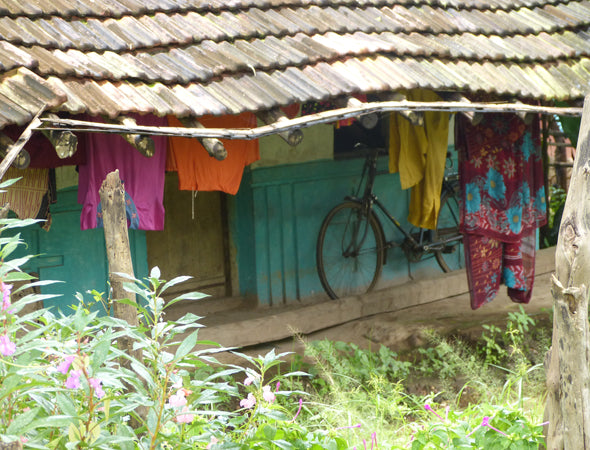The online shop is closed until September 29 2024 when Sally returns from India


I have just returned from an amazing experience, discovering the exotic and intricate patchworks of the Siddi women's quilting co-operative. We nearly didn't arrive at our destination as the only airline to the nearest town (3 hours drive away) went broke. We were stuck in a 1950's propeller plane on the tarmac for 4 hours. No air conditioning, pouring monsoon rains and pitch darkness with the pilot mumbling in Hinglish "there seems to be a fuel problem". Close to midnight the hat was passed around and the little red fuel truck thundered onto the tarmac and filled us up and off we went. The next day we set out with a car and driver to the patchworkers ' tiny village at the edge of a teak forest in Karnataka. Passing endless Tibetan buddhist monasteries and misty monsoonal farm lands, we finally arrived at the little convent where we were to stay. Surrounded by lush barley and corn meadows. Papayas falling off the trees and wonderful vegetable gardens, the convent is run by the Sisters of the Holy Cross. Sister Valentine D' Souza was our brilliant hostess who performs all sorts of miracles working with the Siddis and other marginalized groups in Karnataka. Speaking perfect English (and many other languages) she made us feel instantly at home and showed us to our room with pink rose cotton sheets and blue mozzy nets. We spent many hours wandering round the village, visiting many different quilters in their homes, watching them create these exquisite quilts (also known as Kawandi).
The Siddis are descendants of enslaved Africans bought to Goa by the Portuguese between the 16th and 19th centuries. They gradually moved south into the remote regions of Northern Karnataka and live in small villages scattered in the forests. Traditionally their patchworks were used for family members and sleeping mattresses in warm weather or covers during the monsoon season. Baby quilts for their wooden cribs and huge ones for three or more persons. The art form is never taught, it is instinctive and was used by the slaves as a secret communication between each other. For example if a quilt was turned over in the evening it meant they were going to escape that night. Now many quilters are older women who can no longer work in the fields, younger women also make the quilts. Some work together, others alone. They work whenever they have a free moment from their incredibly long days of cooking,farming,and minding their children. Each quilt is unique and every quilt a work of art. I adored them all and purchased a few to exhibit and sell at my show in December at Shapiro Gallery.

The luscious barley crop with handmade stick fences

The mud houses painted stunning colours



Voodoo Heaven






A large patchwork takes four months to make






Sister Valentine D' Souza second from right with her 3 nuns